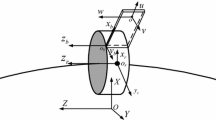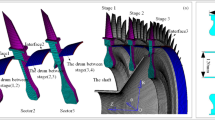Abstract
Purpose
In the dynamic analysis of bladed rotors, bladed disks and rotors tend to be dealt with independently, where the former ones usually neglect the flexibility of shaft and the latter ones often assume the blade and disk to be rigid. This paper integrates these two aspects and presents a model order reduction method for bladed rotors supported by journal bearings.
Methods
The coupling vibration characteristics of a bladed rotor-bearing system are addressed, where the mistuning in blades and disk is taken into account. The governing equations of motion of rotating bladed rotor-bearing systems are developed by employing 3D finite element (FE) model and the eight-coefficient model of bearing. The order of the model is significantly reduced before further analysis, and the mistuning in blades and disk are integrated into the reduced-order model (ROM).
Results and Conclusion
The effectiveness of the proposed method is validated by comparing with the full-order model. Numerical results shown that the flexibility of shaft can lead to significant influences on the responses of mistuned bladed disk, in both one engine order (EO) and higher EOs of excitations. Besides, the bearing stiffness and disk mistuning have also non-negligible effects.




















Similar content being viewed by others
Data Availability
The code/data used to support the findings of this study are available from the corresponding author upon request.
References
Castanier MP, Pierre C (2006) Modeling and analysis of mistuned bladed disk vibration: current status and emerging directions. J Propul Power 22(2):384–396
G. Genta, Dynamics of rotating systems, Springer Science & Business Media2007.
Yuan J, Scarpa F, Allegri G, Titurus B, Patsias S, Rajasekaran R (2017) Efficient computational techniques for mistuning analysis of bladed discs: a review. Mech Syst Signal Process 87:71–90
Loewy RG, Khadert N (1984) Structural dynamics of rotating bladed-disk assemblies coupled with flexible shaft motions. AIAA J 22(9):1319–1327
Crawley EF, Ducharme EH, Mokadam DR (1986) Analytical and experimental investigation of the coupled bladed disk/shaft whirl of a cantilevered turbofan. J Eng Gas Turbines Power 108(4):567–575
Khader N, Robert L (1989) Shaft flexibility effects on Aeroelastic stability of a rotating bladed disk. J Propul Power 5(6):718–726
Khader N, Loewy RG (1990) Shaft flexibility effects on the forced response of a bladed-disk assembly. J Sound Vib 139(3):469–485
Huang SC, Ho KB (1996) Coupled shaft-torsion and blade-bending vibrations of a rotating Shaft–Disk–Blade unit. J Eng Gas Turbines Power 118(1):100–106
Jacquet-Richardet G, Ferraris G, Rieutord P (1996) Frequencies and modes of rotating flexible bladed disc-shaft assemblies: a global cyclic symmetry approach. J Sound Vib 191(5):901–915
Al-Bedoor BO (1999) Dynamic model of coupled shaft torsional and blade bending deformations in rotors. Comput Methods Appl Mech Eng 169(1):177–190
Al-Bedoor B (2001) Reduced-order nonlinear dynamic model of coupled shaft-torsional and blade-bending vibrations in rotors. J Eng Gas Turbines Power 123(1):82–88
Masoud SA, Alhuniti NS (2005) Effect of support stiffness on the stability of a rotor system with blade flexibility. Int J Model Simul 25(2):127–134
Turhan Ö, Bulut G (2006) Linearly coupled shaft-torsional and blade-bending vibrations in multi-stage rotor-blade systems. J Sound Vib 296(1):292–318
Huang S, Chiu Y (2007) Shaft-torsion and blade-bending coupling vibrations in a rotor system with grouped blades. J Syst Design Dynamics 1(4):748–759
Yang C-H, Huang S-C (2007) Coupling vibrations in rotating shaft-disk-blades system. J Vib Acoust 129(1):48–57
Yang C-H, Huang S-C (2007) The influence of disk’s flexibility on coupling vibration of Shaft–Disk–Blades systems. J Sound Vib 301(1):1–17
Wang L, Cao DQ, Huang W (2010) Nonlinear coupled dynamics of flexible Blade–Rotor–Bearing systems. Tribol Int 43(4):759–778
Diken H, Alnefaie K (2011) Effect of unbalanced rotor whirl on blade vibrations. J Sound Vib 330(14):3498–3506
Chiu Y, Chen D (2011) The coupled vibration in a rotating multi-disk rotor system. Int J Mech Sci 53(1):1–10
Ma H, Lu Y, Wu Z, Tai X, Li H, Wen B (2015) A new dynamic model of rotor–blade systems. J Sound Vib 357:168–194
Ma H, Lu Y, Wu Z, Tai X, Wen B (2016) Vibration response analysis of a rotational shaft–disk–blade system with blade-tip rubbing. Int J Mech Sci 107:110–125
Wang N, Liu C, Jiang D, Behdinan K (2019) Casing vibration response prediction of dual-rotor-blade-casing system with blade-casing rubbing. Mech Syst Signal Process 118:61–77
She H, Li C, Tang Q, Wen B (2018) The investigation of the coupled vibration in a flexible-disk blades system considering the influence of shaft bending vibration. Mech Syst Signal Process 111:545–569
Khader N, Masoud S (1991) Vibration of mistuned bladed disks supported by flexible continuous shafts. J Sound Vib 149(3):471–488
B. Segui´, E. (2007) Casanova, application of a reduced order modeling technique for mistuned bladed disk-shaft assemblies, ASME Turbo Expo 2007: Power for Land, Sea, and Air, 473-483.
L.A. Boulton, E. (2009) Casanova, Reduced Order Model for a Two Stage Gas Turbine Including Mistuned Bladed Disks and Shaft Interaction, ASME Turbo Expo 2009: Power for Land, Sea, and Air, 281-290
Wang S, Bi C-X, Zheng J-Z (2019) A reduced-order model for the vibration analysis of mistuned Blade–Disc–Shaft assembly. Appl Sci 9(22):4762
Chiu Y, Huang S (2008) The influence of a mistuned blade’s staggle angle on the vibration and stability of a Shaft-Disk-Blade assembly. Shock Vib 15(1):3–17
Kim K-T (2015) Whirl speeds of mistuned bladed rotors supported by isotropic stator. J Sound Vib 357:409–426
Li C, She H, Tang Q, Wen B (2019) The coupling vibration characteristics of a flexible shaft-disk-blades system with mistuned features. Appl Math Model 67:557–572
J.J. Yu, (1997) Dynamic Analysis of Rotor-Bearing Systems Using Three-Dimensional Solid Finite Elements, University of Alberta.
Feiner DM, Griffin JH (2002) A Fundamental Model of Mistuning for a Single Family of Modes. J Turbomach 124(4):597–605
Lim SH, Bladh R, Castanier MP, Pierre C (2009) Compact, Generalized Component Mode Mistuning Representation for Modeling Bladed Disk Vibration. AIAA J 45(9):2285–2298
M. Castanier, C. Pierre, (1998) Investigation of the combined effects of intentional and random mistuning on the forced response of bladed disks, 34th AIAA/ASME/SAE/ASEE Joint Propulsion Conference and Exhibit, American Institute of Aeronautics and Astronautics.
J. Li, M. Castanier, C. Pierre, S. Ceccio, (2006) Experimental Monte Carlo Mistuning Assessment of Bladed Disk Vibration Using Forcing Variations, 47th AIAA/ASME/ASCE/AHS/ASC Structures, Structural Dynamics, and Materials Conference, American Institute of Aeronautics and Astronautics.
Acknowledgements
This work was supported by the Project of National Natural Science Foundation of China (No. 51805130) and the Fundamental Research Funds for the Central Universities (No. JZ2020HGTB0046).
Author information
Authors and Affiliations
Corresponding author
Ethics declarations
Conflict of Interest
The authors declare that there is no conflict of interest.
Additional information
Publisher's Note
Springer Nature remains neutral with regard to jurisdictional claims in published maps and institutional affiliations.
Rights and permissions
Springer Nature or its licensor (e.g. a society or other partner) holds exclusive rights to this article under a publishing agreement with the author(s) or other rightsholder(s); author self-archiving of the accepted manuscript version of this article is solely governed by the terms of such publishing agreement and applicable law.
About this article
Cite this article
Wang, S., Li, J. & Sun, L. Reduced-Order Modeling for the Coupling Vibration Analysis of Bladed Rotors Supported by Journal Bearings. J. Vib. Eng. Technol. 12, 3823–3839 (2024). https://doi.org/10.1007/s42417-023-01088-z
Received:
Revised:
Accepted:
Published:
Issue Date:
DOI: https://doi.org/10.1007/s42417-023-01088-z




